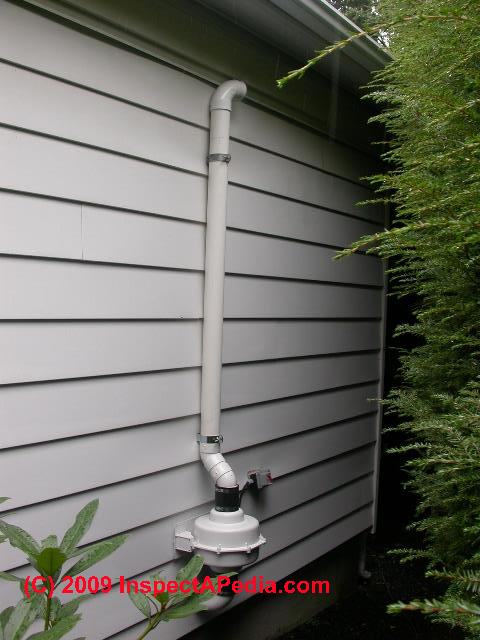Where is Radon most commonly found?
There's no single method that fits all radon removal system needs. Common techniques include: Sub-slab depressurization, where suction pipes are inserted through the floor or concrete slab into the concrete slab below the home. A radon vent fan then draws out the radon gas and releases it into the air outside.
Sight the updated "Resident's Overview to Radon" for more details about examining your residence. Radon originates in granite deposits located deeply underground. The gas can enter structures by leaking in through fractures in the structure, openings around drains or under cellar pieces.
Radon is the second leading root cause of lung cancer cells and is estimated to cause tens of countless lung cancer deaths in the UNITED STATE every year. To decrease the threat of lung cancer cells from direct exposure to radon, EPA suggests testing all homes for radon and also reducing high levels, regardless of whether the house consists of granite countertops.
Does seller have to fix radon?


It's very likely that your future buyer Click for more will make you fix the radon problem before they will purchase the home. It's good to just take care of it during your real estate deal. Sometimes the seller pays for it all, sometimes they fund a credit and sometimes there is a split.
For exposure criteria to be efficient, they need to be set for those most prone. You can not see, scent or taste radon, but it may be a problem in your house. The Doctor General has actually alerted that radon is the second leading root cause of lung cancer cells in the United States today. You're at high danger for creating lung cancer cells if you smoke and your house has high radon degrees. Some clinical researches of radon exposure suggest that youngsters may be more conscious radon.
What kind of cancer is caused by radon?
Radon decays quickly, giving off tiny radioactive particles. When inhaled, these radioactive particles can damage the cells that line the lung. Long-term exposure to radon can lead to lung cancer, the only cancer proven to be associated with inhaling radon.
Radon address search
The US EPA in 1988 encouraged that all homes be looked for radon degrees. Affordable residence radon detectors are offered that fulfill EPA criteria. In 1988, the EPA approximated that radon adds to in between 7000 and 30,000 cases of lung cancer cells each year, or up to 10 percent of all lung cancer cells fatalities in the UNITED STATES. In 2009, the WHO approximated that 5-- 15 percent of all lung cancers cells are triggered by radon, which is the key root cause of lung cancer among non-smokers.
Is radon really a big deal?
Radon is a radioactive gas that has been found in homes all over the United States. It comes from the natural breakdown of uranium in soil, rock, and water and gets into the air you breathe. Radon typically moves up through the ground to the air above and into your home through cracks and other holes in the foundation.
According to the Epa, radon is just one of one of the most significant illness encountering our populace today. While this gas does not pose immediate health and wellness runs the risk of the method carbon monoxide gas does, in time, radon direct exposure can considerably raise one's danger for lung cancer cells. Actually, radon direct exposure is the 2nd leading reason for lung cancer cells in this country, right behind cigarette smoke. It is odor-free, chemically non-active as well as anemic, a natural item of the fragmentation of uranium.
Why is radon bad for you?
Radon produces a radioactive dust in the air we breathe. The dust is trapped in our airways and emits radiation that damages the inside of our lungs. This damage, like the damage caused by smoking, increases our risk of lung cancer.
Where is radon found in the home?
Radon is a radioactive gas that has been found in homes all over the United States. It comes from the natural breakdown of uranium in soil, rock, and water and gets into the air you breathe. Radon typically moves up through the ground to the air above and into your home through cracks and other holes in the foundation.
How do I know if my house has radon?
In fact, you're probably breathing it in every day, even if it's at a low level. However, you can't tell if you're breathing it in at a high level. The danger in radon exposure is that you can't see it, taste it, or smell it. And you won't have any symptoms to alert you.
- The Canadian standard for radon in interior air for houses is 200 Becquerels per cubic metre (200 Bq/m3).
- Throughout the years, information that tracks radon degrees indicates that a huge percent of Pennsylvania houses have a severe radon problem.
- Radon gas threatens, and also if the trouble goes neglected, the radon concentration continues to increase inside your residence.
- Because of their proximity to the location, New Jersey residences and also Delaware homes are considered at threat as well.
- Radon gas enters your house or other home from the outdoors, and with time, slowly builds up to unsafe levels that can lead to a boosted danger of lung cancer or respiratory system problems.
What is radon in the home?
Radon is a radioactive gas that has been found in homes all over the United States. It comes from the natural breakdown of uranium in soil, rock, and water and gets into the air you breathe. Radon typically moves up through the ground to the air above and into your home through cracks and other holes in the foundation.
What causes radon?
Being exposed to radon for a long period of time can lead to lung cancer. Radon gas in the air breaks down into tiny radioactive elements (radon progeny) that can lodge in the lining of the lungs, where they can give off radiation. This radiation can damage lung cells and eventually lead to lung cancer.
How do I make my house safe from radon?
Install a layer of gas-permeable aggregate, such as four inches of gravel, beneath the slab https://www.sendspace.com/file/ol16iy or flooring system of your home if you don't have a crawlspace. Cover this layer or your crawlspace floor with plastic sheeting to stop radon gas from moving past that level and into your home.
Would you buy a house with radon?
Radon is a naturally occurring radioactive gas which may be found in indoor environments such as homes, schools, and workplaces. Radon is the most important cause of lung cancer after smoking.
Does home insurance cover radon mitigation?
homeowners insurance and radon remediation While home insurance is designed to financially protect you from sudden and unexpected perils such as fire or theft, it typically won't cover things that can be considered related to home maintenance like radon testing and mitigation.
Should I buy a house with high radon?
EPA RECOMMENDS: If you are buying or selling a home, have it tested for radon. For a new home, ask if radon-resistant construction features were used and if the home has been tested. Fix the home if the radon level is 4 picocuries per liter (pCi/L) or higher.
Does Radon make you tired?
The more uranium there is, the more radon there is. That makes radon the second leading cause of lung cancer after smoking. But even minor symptoms like headaches, feeling unusually tired, itching or burning eyes, irritated skin, nasal congestion, a dry throat or nausea could be due to your home's indoor air quality.
Can I install my own radon mitigation system?
In most cases, pros charge about $1,500 to install a radon mitigation system, but you can do it yourself for only about $500 in materials. So if you're fairly handy and have some carpentry, plumbing and electrical skills, you can install your own system in a weekend and save yourself a thousand bucks!